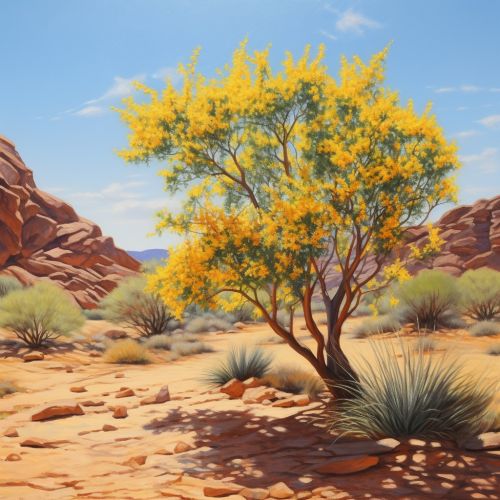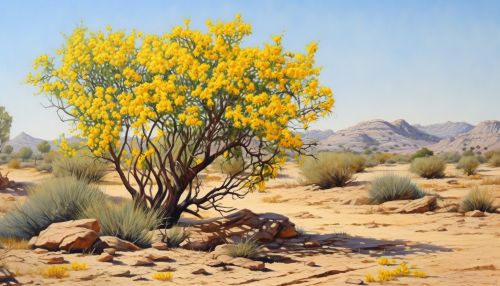Creosote bush
Introduction
The Creosote bush (Larrea tridentata) is a plant species native to the southwestern United States and northern Mexico. This evergreen shrub is well-adapted to arid environments and is a dominant species in various ecosystems, including the Mojave Desert, Sonoran Desert, and Chihuahuan Desert. The Creosote bush is known for its resilience and longevity, with some specimens estimated to be over 11,000 years old.
Description
The Creosote bush is a medium-sized shrub, typically reaching heights of 1 to 3 meters. It has small, resinous leaves that are dark green in color and waxy in texture, which help to minimize water loss in the arid environments it inhabits. The plant produces bright yellow flowers, which are followed by small, white, fuzzy fruit. The bush's common name, "Creosote," comes from the strong, distinctive smell of its leaves, especially after rainfall, which is reminiscent of the smell of the Creosote oil used as a wood preservative.
Distribution and habitat
The Creosote bush is found throughout the southwestern United States, particularly in the states of California, Arizona, Nevada, and New Mexico, as well as in northern Mexico. It thrives in arid environments, particularly in desert ecosystems. The plant is highly adaptable and can grow in a variety of soil types, including sandy, gravelly, and rocky soils. It is often found in areas with low annual rainfall and extreme temperature fluctuations.
Ecology
The Creosote bush plays a significant role in the ecosystems it inhabits. It is a dominant species in many desert ecosystems, often forming dense, monospecific stands. The plant has several adaptations that allow it to survive in arid environments, including a deep root system that allows it to access groundwater, and small, waxy leaves that minimize water loss. The Creosote bush is also a key food source for various animals, including the Desert Tortoise and numerous species of insects.
Uses
Historically, the Creosote bush has been used by indigenous peoples for a variety of purposes. The plant's resinous leaves were often used as a source of medicine, with various tribes using it to treat a range of ailments, from respiratory problems to skin conditions. Today, the Creosote bush is still used in some traditional medicines, although its efficacy is not well-studied. The plant is also used in landscaping, particularly in xeriscaping, a type of landscaping that minimizes water use.
Conservation
While the Creosote bush is not currently considered threatened or endangered, it does face some threats. The plant's habitat is being increasingly fragmented by urban development, particularly in areas like southern California. Additionally, climate change poses a potential threat to the Creosote bush, as increased temperatures and decreased rainfall could impact its ability to survive in its arid habitat.
See Also


